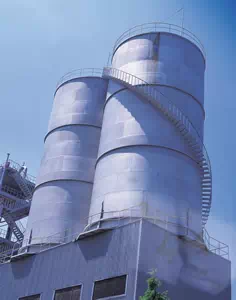Storage Tanks
Aboveground or Underground Oil Storage Containers
EPA's Oil Program web site, provides information about EPA's program for preventing, preparing for, and responding to oil spills that occur in and around inland waters of the United States. If a hospital uses or stores oil it may be subject to the Spill Prevention Control and Countermeasure (SPCC) rule. Hospitals with an above ground oil storage capacity of greater than 1,320 gallons, or total completely buried oil storage capacity greater than 42,000 gallons must prepare and implement a SPCC plan to prevent any discharge of oil into or upon navigable waters of the United States or adjoining shorelines.
The Spill Prevention, Control, and Countermeasure (SPCC) rule was originally promulgated on December 11, 1973 and was revised on July 17, 2002. In December 2006, EPA issued an amendment to address a number of issues raised by its 2002 rule, including those pertaining to facilities with smaller oil storage capacities. On December 5, 2008, EPA amended the SPCC rule again to provide clarity, tailor requirements to particular industry sectors, and streamline certain requirements while maintaining protection of human health and the environment (73 FR 74236). On November 5, 2009, EPA promulgated revisions to the December 2008 amendments. An EPA fact sheet identifies the latest changes. This rule is effective January 14, 2010. On October 7, 2010, EPA extended the compliance date for most facilities until November 10, 2011. Facilities must amend or prepare, and implement SPCC Plans by the compliance date in accordance with revisions to the SPCC rule promulgated since 2002. Note that drilling, production or workover facilities that are offshore or that have an offshore component must still meet the old schedule (11/10/2010).
In the amendments, EPA streamlined and tailored the SPCC requirements for a subset of qualified facilities. The owner or operator of a qualified facility has the option to self-certify his SPCC Plan and comply with other streamlined requirements. This final rule designates a subset of qualified facilities (“Tier I qualified facilities”) as those that meet the current qualified facilities eligibility criteria and that have no oil storage containers with an individual aboveground storage capacity greater than 5,000 U.S. gallons. A Tier I qualified facility has the option to complete a self-certified SPCC Plan template instead of a full SPCC Plan. By completing the SPCC Plan template, an owner or operator of a Tier I qualified facility will certify that the facility complies with a set of streamlined SPCC rule requirements. All other qualified facilities are designated “Tier II qualified facilities.”
Who is subject to the SPCC rule?
The SPCC rule applies to owners or operators of non-transportation-related facilities that:
- Drill, produce, store, process, refine, transfer, distribute, use, or consume oil or oil products; and
- Could reasonably be expected to discharge oil to U.S. navigable waters or adjoining shorelines.
Facilities are subject to the rule if they meet at least one of the following capacity thresholds:
- Aboveground oil storage capacity greater than 1,320 U.S. gallons, [Do not count containers with a storage capacity less than 55 U.S. gallons.], or
- Completely buried oil storage capacity greater than 42,000 U.S. gallons.




